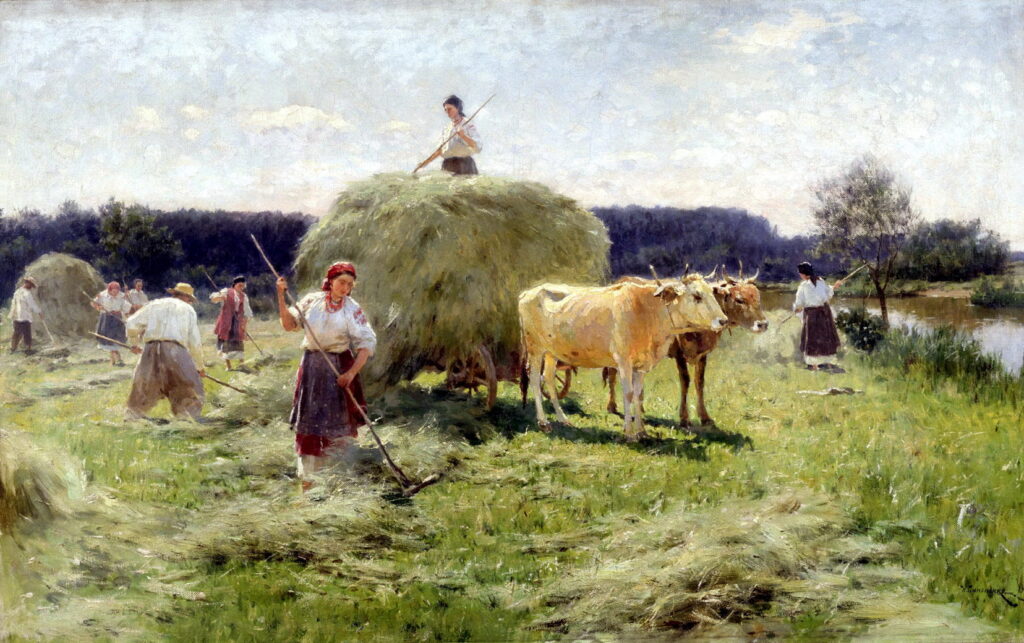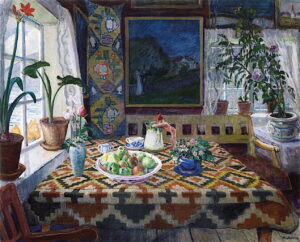The Real Country: Hay

In the more northerly latitudes, grass that’s essential for cattle to graze grows little during the winter months. Farmers keeping cattle therefore have to provide alternative feed for their livestock for several months each year. This can include root crops such as brassica varieties including turnips and swedes (also known as rutabaga), but the most widespread is cut and dried grass as hay.
Where climate and day-length are suitable, as in much of England and France, dedicated hay meadows can provide two harvests each year. Left ungrazed through the winter, the first is normally ready to mow in the late Spring, and when there’s sufficient rainfall during the early summer, a second hay harvest can be obtained before the weather deteriorates in the early autumn. The mowing of hay has also been known as math, and mowing a second time is thus the aftermath or lattermath.
The essential requirement for hay is that it’s dried thoroughly, or it will rot over time and become unusable as fodder. In the centuries before mechanisation during the nineteenth century, this process was described as: first mow the grass, “scatter it about, gather it in windrows, cock it overnight, scatter it about, windrow it, cock it, and so on to the stack and stack it”. (Fussell) Those steps are shown well in paintings.
Pieter Bruegel the Elder (c 1525–1569), The Hay Harvest (1565), oil on panel, 114 x 158 cm, Lobkowicz Palace, Prague, Czechia. Wikimedia Commons.
The companion to Pieter Bruegel the Elder’s painting of the grain harvest, The Hay Harvest from 1565 shows all stages in progress. In the left foreground a man is beating the blade on his scythe to sharpen it ready for mowing. Three women are striding towards him with the rakes they use to scatter and gather the mown hay. Behind them, in the valley, others are gathering the hay into small stacks or cocks, where it continues to dry before being loaded onto the hay wagon to be taken back to the farm.
At the right are wicker baskets containing other crops, including what appear to be peas or beans, together with a red fruit.
Ferdinand Hodler (1853–1918), The Mower (c 1898), oil on canvas, 71.5 × 114 cm, Private collection. Wikimedia Commons.
Ferdinand Hodler’s marvellous Mower from about 1898 is seen sharpening the blade on his heavy scythe using a whetstone, as the sun rises behind and to the left.
Jules Bastien-Lepage (1848–1884), Les Foins (Haymakers) (1877), oil on canvas, 160 x 195 cm, Musée d’Orsay, Paris. Wikimedia Commons.
The couple in Jules Bastien-Lepage’s Haymakers from 1877 are enjoying a short break from their labours, with the mown hay behind them still scattered to dry, before it can be raked into cocks.
Henri-Jean Guillaume Martin (1860–1943), Summer, or Mowers (1903), oil on canvas, dimensions not known, Capitole de Toulouse, Toulouse, France. Image by Didier Descouens, via Wikimedia Commons.
Henri-Jean Martin painted Summer, or Mowers in 1903, as mechanisation was spreading across Europe. Several small clusters of men are mowing the hay in this meadow with their scythes, as three young women are dancing in a ring on the bed of flowers, and another sits nursing an infant.
Henry Moret (1856–1913), Haymaking in Brittany (1906), oil on canvas, dimensions not known, Musée des beaux-arts de Vannes, Vannes, France. Wikimedia Commons.
Henry Moret’s Haymaking in Brittany from 1906 shows a smaller team busy mowing and raking on steeper ground.
Camille Pissarro (1830–1903), Haymaking, Éragny (1887), oil on canvas, 50 x 66 cm, Van Gogh Museum, Amsterdam, The Netherlands. Wikimedia Commons.
In Camille Pissarro’s Divisionist painting of Haymaking, Éragny from the summer of 1887, a team of women are raking the cocks into haystacks.
Mykola Pymonenko (1862–1912), Haymaking (date not known), oil on canvas, dimensions not known, Fine Arts Museum Kharkiv Харківський художній музей, Kharkiv, Ukraine. Wikimedia Commons.
Women in this hay meadow in Ukraine are raking in the harvest to be transported by a hay wain drawn by a pair of oxen, as painted in Mykola Pymonenko’s undated Haymaking.
Jean-François Millet (1814–1875), Haystacks: Autumn (c 1874), oil on canvas, 85.1 x 110.2 cm, The Metropolitan Museum of Art, New York, NY. Wikimedia Commons.
In Jean-François Millet’s Haystacks: Autumn from about 1874, the harvest has been gathered, and three huge haystacks dominate the canvas. At the foot of one of them, a shepherd leans on his staff, resting from his labours as his flock grazes on the stubble.
Surplus hay was also a good cash crop for those who could get it transported to towns and cities. Along the east coast of England, barges were filled with hay then taken to London for sale. Much of the land in the county of Middlesex, to the west of London, was devoted to producing hay to feed horses in the city.
Robert Bevan (1865–1925), Hay Carts, Cumberland Market (1915), oil on canvas, 47.9 x 61 cm, Yale Center for British Art, New Haven, CT. Wikimedia Commons.
Robert Bevan’s painting of Hay Carts, Cumberland Market from 1915 is a view of London’s last hay market, near to the artist’s studio. By this time, the bales shown were made by mechanical baling machines and brought to London by barge.
In the next article in this series, I’ll look at a novel crop that soon became the staple food for many, the potato.




